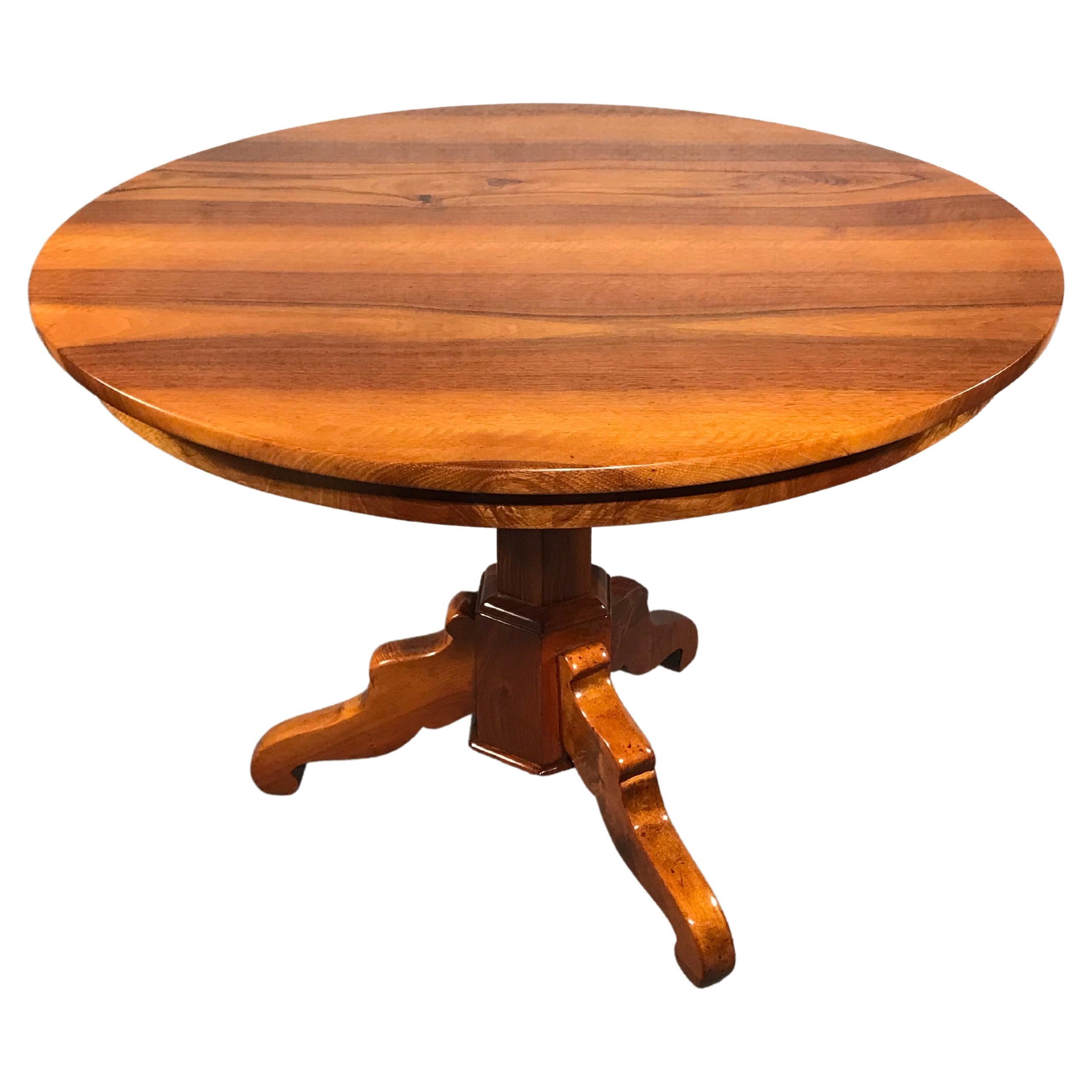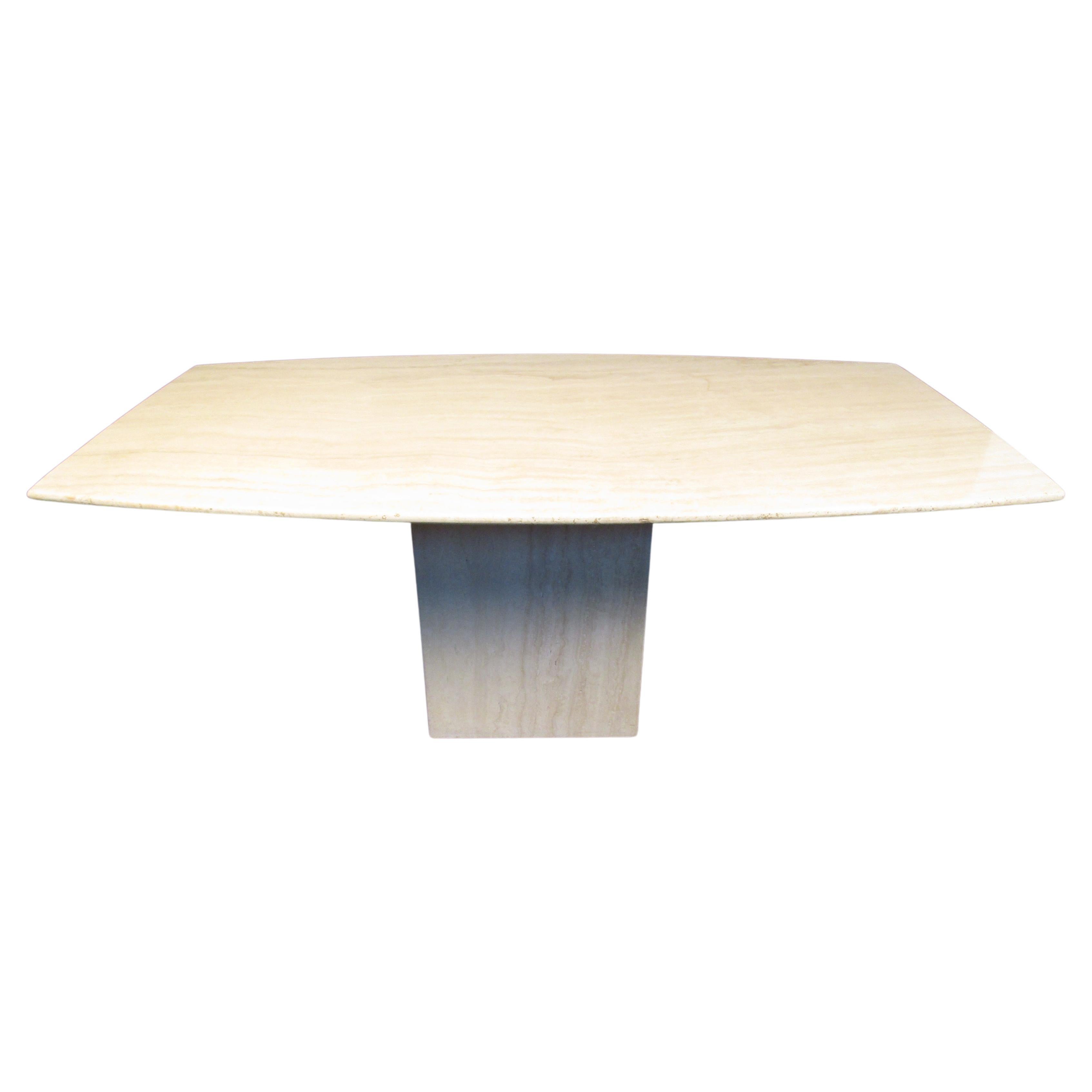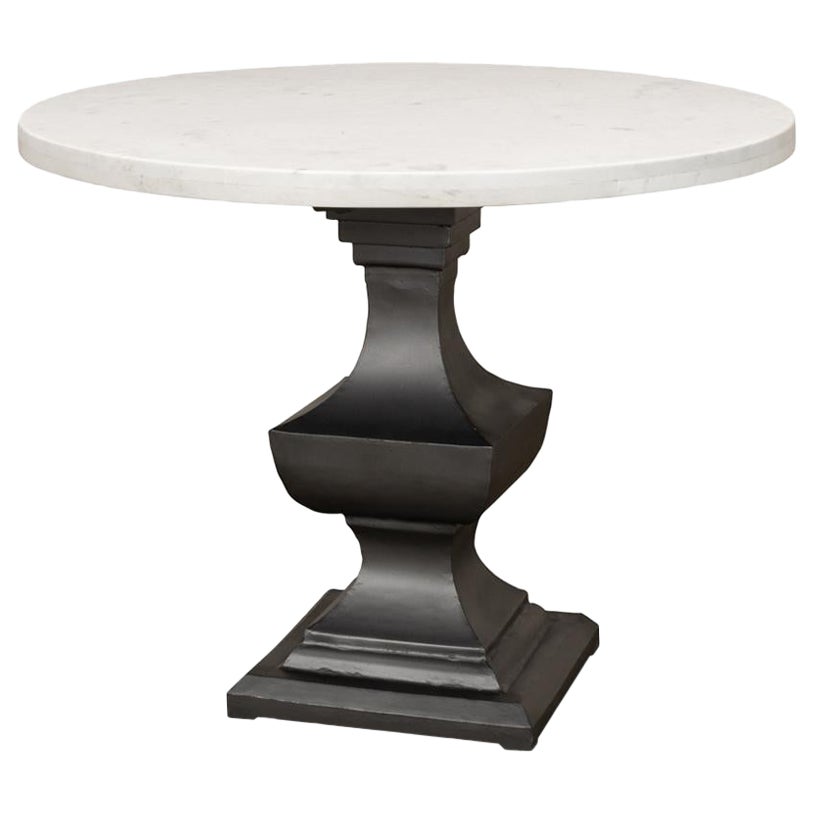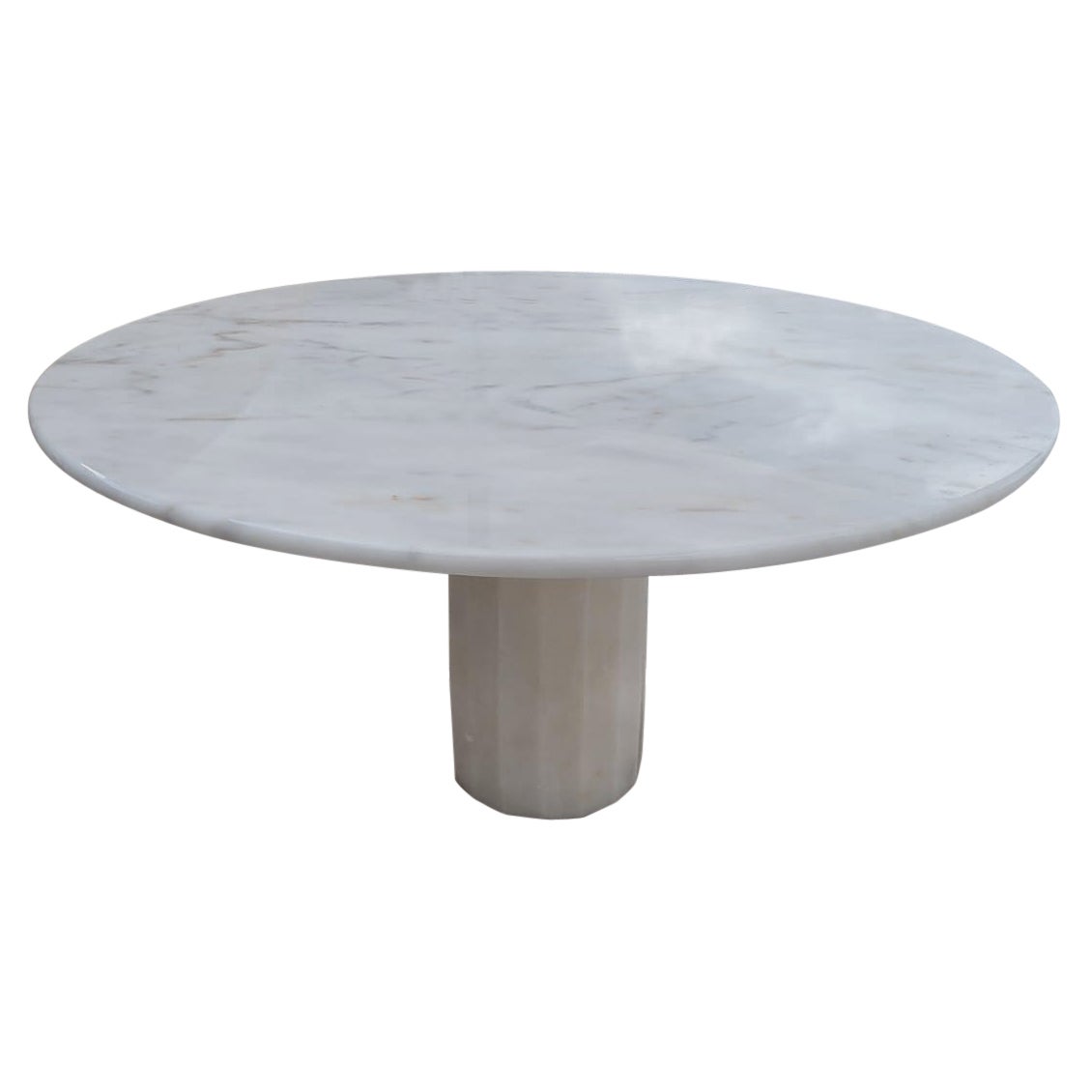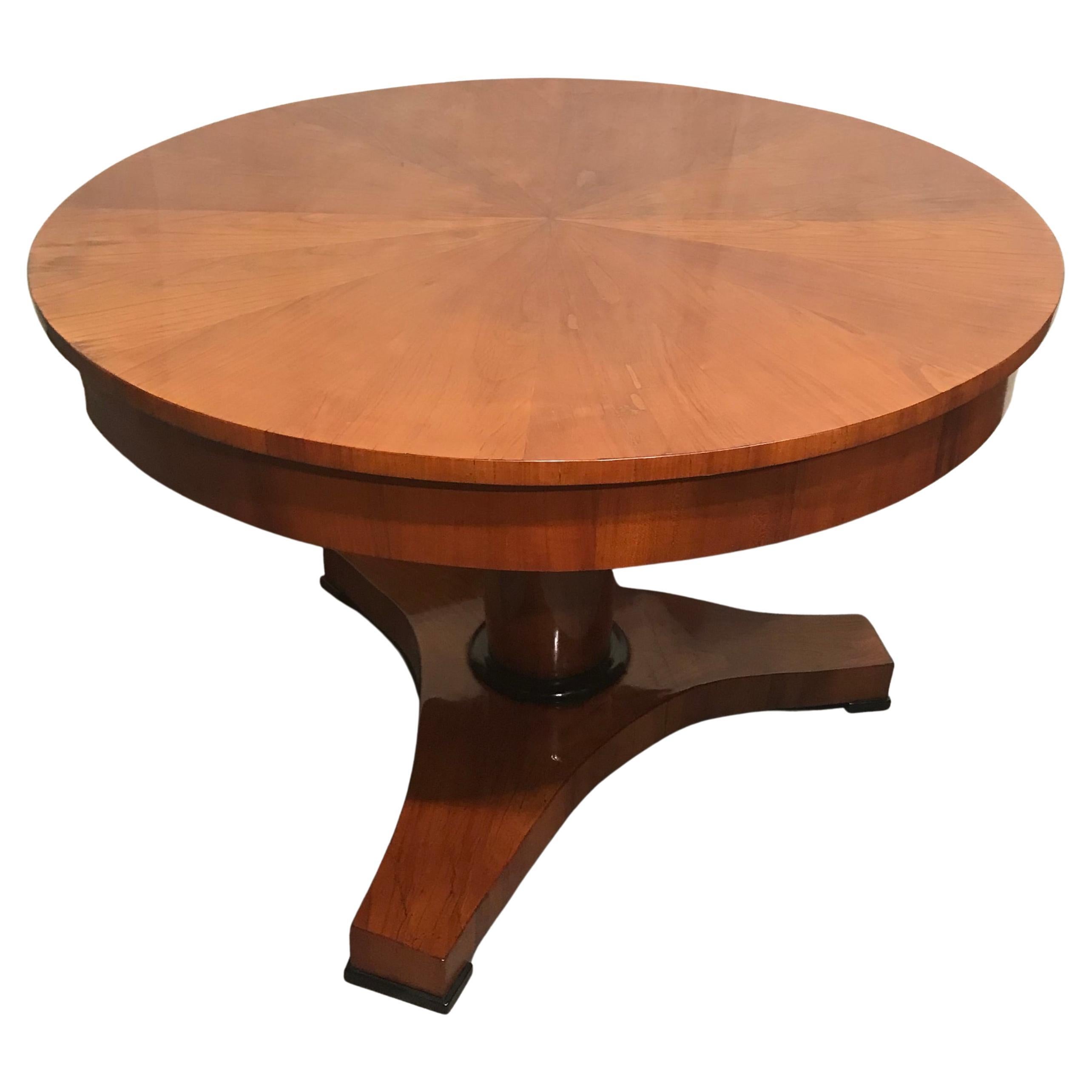Items Similar to Biedermeier Style Dining Table with Marble
Want more images or videos?
Request additional images or videos from the seller
1 of 9
Biedermeier Style Dining Table with Marble
About the Item
Biedermeier dining table with bird's-eye maple veneer and Carrara marble. Could be used in a library, as an entry table, dining table or even a desk. This piece of art has an acanthus leaf design atop capitals of the column legs with black ebonized wood accents and fish scale details along the apron and base of the stretcher.
The Biedermeier period refers to an era in Central Europe between 1815 and 1848, during which the middle class grew in number, and arts appealed to common sensibilities. It began with the time of the Congress of Vienna at the end of the Napoleonic Wars and ended with the onset of the European Revolutions of 1848. Although the term itself is a historical reference, it is used mostly to denote the artistic styles that flourished in the fields of literature, music, the visual arts and interior design.
Biedermeier was an influential German style of furniture design that evolved during the years 1815–1848. The period extended into Scandinavia, as disruptions due to numerous states that made up the German nation were not unified by rule from Berlin until 1848. These post-Biedermeier struggles, influenced by historicism, created their own styles. Throughout the period, emphasis was kept upon clean lines and minimal ornamentation consistent with Biedermeier's basis in utilitarian principles. As the period progressed, however, the style moved from the early rebellion against Romantic-era fussiness to increasingly ornate commissions by a rising middle class, eager to show their newfound wealth. The idea of clean lines and utilitarian postures would resurface in the 20th century, continuing into the present day. Middle- to late-Biedermeier furniture design represents a heralding towards historicism and revival eras long sought for. Social forces originating in France would change the artisan-patron system that achieved this period of design, first in the Germanic states and, then, into Scandinavia. The middle class growth originated in the English Industrial revolution and many Biedermeier designs owe their simplicity to Georgian lines of the 19th century, as the proliferation of design publications reached the loose Germanic states and the Austro-Hungarian Empire.
The Biedermeier style was a simplified interpretation of the influential French Empire Style of Napoleon I, which introduced the romance of ancient Roman Empire styles, adapting these to modern early 19th-century households. Biedermeier furniture used locally available materials such as cherry, ash and oak woods rather than the expensive timbers such as fully imported mahogany. Whilst this timber was available near trading ports such as Antwerp, Hamburg and Stockholm, it was taxed heavily whenever it passed through another principality. This made mahogany very expensive to use and much local cherry and pearwood was stained to imitate the more expensive timbers. Stylistically, the furniture was simple and elegant. Its construction utilized the ideal of truth through material, something that later influenced the Bauhaus and Art Deco periods.
Many unique designs were created in Vienna, primarily because a young apprentice was examined on his use of material, construction, originality of design, and quality of cabinet work, before being admitted to the league of approved master cabinetmakers. Furniture from the earlier period (1815–1830) was the most severe and neoclassical in inspiration. It also supplied the most fantastic forms which the second half of the period (1830–1848) lacked, being influenced by the many style publications from England. Biedermeier furniture was the first style in the world that emanated from the growing middle class. It preceded Victorian and influenced mainly Germanic-speaking countries. In Sweden, Marshal Bernadotte, whom Napoleon appointed as ambassador to Sweden to sideline his ambitions, abandoned his support for Napoleon in a shrewd political move. Later, after being adopted by the king of Sweden (who was childless), he became Sweden's new king Karl Johan. The Swedish Karl Johan style, similar to Biedermeier, retained its elegant and blatantly Napoleonic style throughout the 19th century.
Biedermeier furniture and lifestyle was a focus on exhibitions at the Vienna applied arts museum in 1896. The many visitors to this exhibition were so influenced by this fantasy style and its elegance that a new resurgence or revival period became popular amongst European cabinetmakers. This revival period lasted up until the Art Deco style was taken up. Biedermeier also influenced the various Bauhaus styles through their truth in material philosophy.
- Dimensions:Height: 32.063 in (81.44 cm)Width: 74 in (187.96 cm)Depth: 40.5 in (102.87 cm)
- Style:Biedermeier (In the Style Of)
- Materials and Techniques:
- Place of Origin:
- Period:
- Date of Manufacture:20th Century
- Condition:Wear consistent with age and use. The original marble has been replaced with a white carrara marble which has a few fine scratches. There is a small indentations to one of the wood columns. It is is over all great condition.
- Seller Location:Los Angeles, CA
- Reference Number:1stDibs: LU4655215623332
About the Seller
5.0
Vetted Seller
These experienced sellers undergo a comprehensive evaluation by our team of in-house experts.
Established in 2001
1stDibs seller since 2019
35 sales on 1stDibs
Typical response time: <1 hour
- ShippingRetrieving quote...Ships From: Los Angeles, CA
- Return PolicyA return for this item may be initiated within 3 days of delivery.
More From This SellerView All
- Carlo Scarpa Black Marble Dining Table for Cattelan ItaliaBy Carlo Scarpa, Cattelan ItaliaLocated in Los Angeles, CACarlo Scarpa postmodern black madagascar dining table, 1970's. Carlo Scarpa was a famous Italian furniture designer and architect, influenced b...Category
Vintage 1970s Italian Mid-Century Modern Dining Room Tables
MaterialsMarble, Carrara Marble
- Set of Milo Baughman Biedermeier Lounge Chairs for Thayer CogginBy Milo Baughman, Thayer CogginLocated in Los Angeles, CAThis Biedermeier 90 collection, Milo Baughman did with Thayer Coggin in the is one of the last collections Milo and Coggin did together in the 1990's. Milo Baughman believed the midcentury style needed to be warmed up a bit. For admirers of Biedermeier furniture, the neoclassical style that flourished in Austria and Germany from 1815-1830, the choices are few: scarce and expensive antique pieces and now, Milo Baughman's Biedermeier 90 collection for Thayer Coggin, a furniture maker in High Point, N.C. ''When I teach the history of modern design, I start with Biedermeier, because it's the first indication that there would be a new philosophy in design, furniture designed to be more honest and simple,'' said Mr. Baughman, who has designed furniture for Thayer Coggin since 1953 and also teaches design at Brigham Young University in Provo, Utah. The 27-piece collection, which includes consoles, tables and upholstered seating, captures the spirit of Biedermeier design with honey-colored wood veneers, neoclassical fluted columns and natural steel finishes. - Ref NYTIMES, 8/10/1989 “Eurostyle started out as a fairly valid design statement,” says Milo Baughman, a highly regarded veteran furniture designer who teaches at Brigham Young University in Provo, Utah. ''But when it was reduced to more commercial levels and picked up too quickly by people who make cheap furniture...Category
1990s American Biedermeier Club Chairs
MaterialsMaple, Fabric
- Spanish Colonial Style Hand Carved BenchLocated in Los Angeles, CAA vintage Spanish Colonial style bench which has been bleached, and is hand carved from solid Alder wood. It has been reupholstered in grey rabb...Category
Late 20th Century European Spanish Colonial Benches
MaterialsHardwood
- Maitland Smith Tessellated Marble and Tortoise Shell BoxBy Maitland SmithLocated in Los Angeles, CAMaitland Smith tessellated stone box with a mother of pearl finial handle. The interior of the box is lined with a black felt and has a removable lid. The box rests on sterling silver ball and claw feet as well as the entirety of the box is framed with a sterling silver border. History and craftsmanship for nearly four decades Maitland-Smith has been in the business of creating exquisite and unique decorative accessories, lighting and accent furniture and elegant mirrors from our La Barge Collection. Founded by a London antiques dealer with the eye of a connoisseur, Maitland-Smith has carried on the tradition of creating stunning accents for the home of the highest quality. From the beginning, our many workrooms have been artisan based and employ time-honored techniques developed before the machine age. Many of these skills date back to the world’s earliest civilizations, and are associated with Fine quality furniture and decorative arts. Maitland-Smith is well-known for many handcrafted specialties, including hand carved tropical mahogany, handcut and inlaid exotic wood veneers, lost wax cast metal mounts and decorative objects, as well as, traditional vegetable tanned and hand-tooled leather. Other areas of expertise include finely executed porcelains, sophisticated finishing techniques, and detailed hand painting. Maitland Smith draws inspiration from great works from the 18th, 19th, 20th, and 21st centuries and in collaboration with design partners Tony Duquette Studios and its president, Hutton Wilkinson and also Celerie Kemble, Donald Bustraan...Category
Late 20th Century Philippine Modern Decorative Boxes
MaterialsStone, Marble, Sterling Silver
- 20th Century French Stone Lion with Shield on PedestalLocated in Los Angeles, CA20th century French stone lion holding a shield on a pedestal. A 20th century lion carved from stone holding a crest carved with a lion with wearing a crown. It is a representation o...Category
Early 20th Century French Renaissance Animal Sculptures
MaterialsCast Stone
- Leslie Diamond for Conant Ball Midcentury Set of Side TablesBy Leslie Diamond, Conant BallLocated in Los Angeles, CASolid maple side tables for Conant Ball by Leslie Diamond.Category
Vintage 1950s American Mid-Century Modern Side Tables
MaterialsWood
You May Also Like
- Biedermeier Table, 1830, WalnutLocated in Belmont, MAThis original Biedermeier table dates back to around 1830. It comes from Southern Germany. The table stands on a hexagonal column which rest on a trefoi...Category
Antique 1830s Biedermeier Center Tables
MaterialsWalnut
- Beautiful Marble Dining TableLocated in Brooklyn, NYThis Marble dining table features a rectangular top and full marble base. Designed with Italian influence this piece is stunning and unusual. A pe...Category
Vintage 1960s Mid-Century Modern Dining Room Tables
MaterialsMarble
- Marble Top Dining TableLocated in Westwood, NJMarble top dining table, a wonderful piece that is sure to elevate any dining room. This table boasts a smooth and gleaming 40-inch round whit...Category
21st Century and Contemporary Asian Baroque Dining Room Tables
MaterialsMarble, Metal
- Dining Table with Green Marble Top, Italy 1950sLocated in Wolfurt, ATThis Italian dining table was designed in the 1950s. The extravagant table frame is made of stained solid beechwood, and Alpi Verde marble was used as the m...Category
Vintage 1950s Italian Mid-Century Modern Center Tables
MaterialsMarble
- White Marble Round Dining Table with Hexagon BaseBy Angelo MangiarottiLocated in AMSTERDAM, NLThis Minimalist table is made from white marble, featuring a hexagon shaped foot and a circular travertine tabletop that balances perfectly and sec...Category
2010s Unknown Mid-Century Modern Dining Room Tables
MaterialsMarble
- Biedermeier Table, South Germany, 1820-30Located in Belmont, MAThis original Biedermeier table dates back to around 1820-30 and comes from Southern Germany. The table has a central column which stands on a trefoil base. All parts have a very pretty cherry veneer. The top is decorated with a piecrust cherry veneer. It comes refinished with a shellack finish, but still has signs of its 200 year old age. This perfect center table for an entrance or it would work well as a dining table for 4...Category
Antique 1820s German Biedermeier Center Tables
MaterialsCherry
Recently Viewed
View AllMore Ways To Browse
Dining Center Piece
Center Entry Tables
Marble Table Supports
Table With Birds
Center Base Dining Table
Center Table As Dining Table
Popular Table
Dining Table With Center Base
Table With Column Legs
Dining Table With Center Leg
Vintage Half Table
Vintage Half Tables
World War Table
Center Tables Dining Table Black
Simple Marble Tables
Rising Table
Vintage Industrial Style Table
20th Century Library Table
